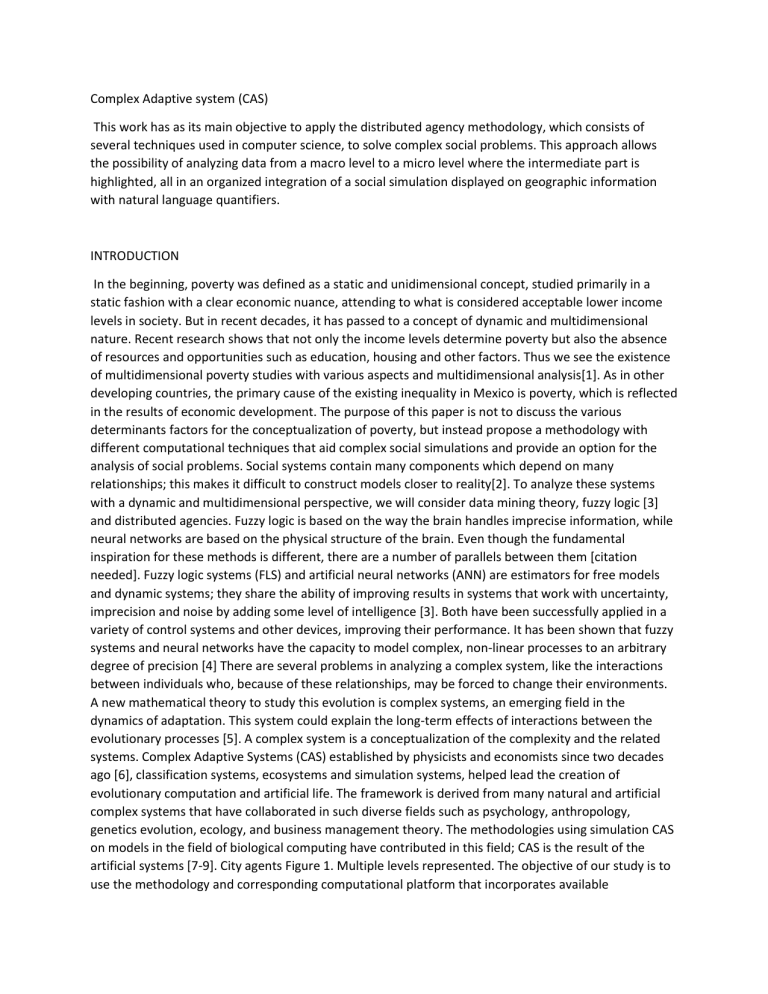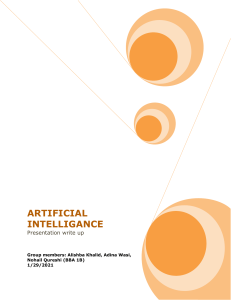
Complex Adaptive system (CAS) This work has as its main objective to apply the distributed agency methodology, which consists of several techniques used in computer science, to solve complex social problems. This approach allows the possibility of analyzing data from a macro level to a micro level where the intermediate part is highlighted, all in an organized integration of a social simulation displayed on geographic information with natural language quantifiers. INTRODUCTION In the beginning, poverty was defined as a static and unidimensional concept, studied primarily in a static fashion with a clear economic nuance, attending to what is considered acceptable lower income levels in society. But in recent decades, it has passed to a concept of dynamic and multidimensional nature. Recent research shows that not only the income levels determine poverty but also the absence of resources and opportunities such as education, housing and other factors. Thus we see the existence of multidimensional poverty studies with various aspects and multidimensional analysis[1]. As in other developing countries, the primary cause of the existing inequality in Mexico is poverty, which is reflected in the results of economic development. The purpose of this paper is not to discuss the various determinants factors for the conceptualization of poverty, but instead propose a methodology with different computational techniques that aid complex social simulations and provide an option for the analysis of social problems. Social systems contain many components which depend on many relationships; this makes it difficult to construct models closer to reality[2]. To analyze these systems with a dynamic and multidimensional perspective, we will consider data mining theory, fuzzy logic [3] and distributed agencies. Fuzzy logic is based on the way the brain handles imprecise information, while neural networks are based on the physical structure of the brain. Even though the fundamental inspiration for these methods is different, there are a number of parallels between them [citation needed]. Fuzzy logic systems (FLS) and artificial neural networks (ANN) are estimators for free models and dynamic systems; they share the ability of improving results in systems that work with uncertainty, imprecision and noise by adding some level of intelligence [3]. Both have been successfully applied in a variety of control systems and other devices, improving their performance. It has been shown that fuzzy systems and neural networks have the capacity to model complex, non-linear processes to an arbitrary degree of precision [4] There are several problems in analyzing a complex system, like the interactions between individuals who, because of these relationships, may be forced to change their environments. A new mathematical theory to study this evolution is complex systems, an emerging field in the dynamics of adaptation. This system could explain the long-term effects of interactions between the evolutionary processes [5]. A complex system is a conceptualization of the complexity and the related systems. Complex Adaptive Systems (CAS) established by physicists and economists since two decades ago [6], classification systems, ecosystems and simulation systems, helped lead the creation of evolutionary computation and artificial life. The framework is derived from many natural and artificial complex systems that have collaborated in such diverse fields such as psychology, anthropology, genetics evolution, ecology, and business management theory. The methodologies using simulation CAS on models in the field of biological computing have contributed in this field; CAS is the result of the artificial systems [7-9]. City agents Figure 1. Multiple levels represented. The objective of our study is to use the methodology and corresponding computational platform that incorporates available mathematical and computational theories that have not been appropriately considered in models of complex social phenomena. Even though applications of Multi-Agent Systems (MAS) have been developed for the social sciences, it has been widely considered in other areas such as Artificial Intelligence (AI) [10, 11]. The state-of-the-art in computational capabilities has been incorporated in multiple areas [7-8], particularly as it refers to distributed systems and distributed agencies [9]. 2 METHODOLOGY The modeling of a realistic social system cannot be achieved by resorting to only one particular type of architecture or methodology. The growing methodology of Distributed Agency (DA) represents a promising research avenue with promising generalized attributes, leading to potentially groundbreaking applications in engineering and in the social sciences—areas in which it minimizes the natural distances between physical and sociological nonlinear systems. In this work we thus lay the foundations for a DA description of socioeconomic realities, in a process that weaves different available computational techniques in the context of DA to represent social and individual behavior in a contextualized fashion, accommodating agents with limited rationality and complex interactions. We believe that this research avenue will improve our understanding of social complexity, as it moves the discussion in the field towards the capability of describing the vast array of linear and nonlinear realities, interlocking levels and currently non-consilient theories in existence. The methodology we are aiming to create represents a novel approach to simulation architectures, creating a language that links the social sciences to programmable terminology and that can thus be broadly applied. The methodology of DA represents a general theory of collective behavior and structure formation [12], which intends to redefine agency and reflect it in multiple layers of information and interaction, as opposed to the traditional approach in which agency is only reflected in individual, atomized and isolated agents, as shown in Figure 1. We consider a disentangled agent that is formed by multiple and relatively independent components. Part of the resulting agent’s task is to present alternatives, or ‘fields of action’ to its components. Correspondingly, the composed agent is itself constrained by a field of action that the superstructure to which it belongs presents. We therefore drop customary assumptions made in traditional social disciplines and MAS about what is considered a decision making unit. To arrive at this, we redefine what a unit of decision is by unscrambling behavioral influences to the point of not being able to clearly delineate what the individual is, who is part of a group and who is not, or where a realm of influence ends; the boundary between an individual self and its social coordinates is dissolved. The proposed intermediate agent can be thought of as a person, a family, a social class, a political party, a country at war, a species as a whole, or a simple member of a species trying to survive. The archetype of the agents we attempt to describe can be summarized as a group of colluded oligopolists, such as the oil-producing countries of OPEC. As a whole, they share the common interest of jointly behaving like a monopoly and restricting their production, but they cannot avoid having an incentive to deviate and produce above their quota.


